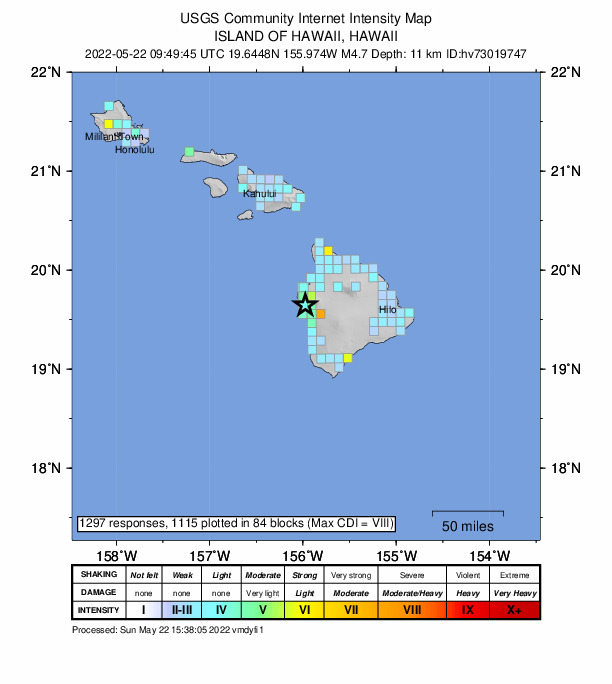4.7 earthquake beneath Hualālai Volcano on Hawaiʻi Island caused by slip along fault, no tsunami generated

A moderate 4.7 earthquake reported late Saturday night was primarily caused by a “lateral slip along a sub-vertical fault,” and does not appear to be directly related to “magmatic activity” at the Hualālai volcano, according to scientists with the US Geological Survey’s Hawaiian Volcano Observatory.
The Pacific Tsunami Warning Center reports that there was no tsunami threat to Hawaiʻi following the earthquake, which was reported at 11:50 p.m. on Saturday, May 21, 2022.
The quake occurred at at a depth of 7 miles, and was located about 1 mile ENE of Kailua-Kona, according to the HVO.
The USGS places the following cities in proximity to the quake:
- Kailua-Kona, Hawaiʻi Island, 1.7 miles W
- Hilo, Hawaiʻi Island, 57.8 miles E
- Hawaiian Paradise Park, Hawaiʻi Island, 65.3 miles E
- Kīhei, Maui, Hawaiʻi, 83.3 miles NNW
- Honolulu, Oʻahu, Hawaiʻi, 167.6 miles NW
There were more than 1,000 “felt” reports within the first hour on the USGS “Did you feel it?” website, with reports coming in from across the state, with more than 300 on Hawaiʻi Island. On Maui, multiple felt reports surfaced from Kīhei, Kula, Makawao and Lahaina. The furthest felt report was generated in Kapaʻa, Kauaʻi, according to USGS data.
The observatory reports that, “Over the past 25 years, there have only been 2 earthquakes with magnitudes greater than 4.0 beneath Hualālai volcano,” including last night’s event.
HVO Scientist-in-Charge Ken Hon commented an informational statement provided by the agency, saying the earthquake had no apparent effect on Mauna Loa or Kīlauea Volcano’s ongoing summit eruption.
According to the HVO, Hualālai is the third most active volcano on the Island of Hawaiʻi and typically erupts two to three times per 1,000 years. The HVO reports that “Hualālai last erupted in 1801 and, more recently, had a damaging seismic swarm in 1929 that was probably the result of a shallow intrusion of magma.”










